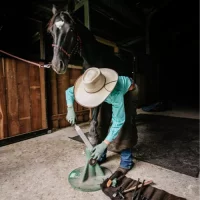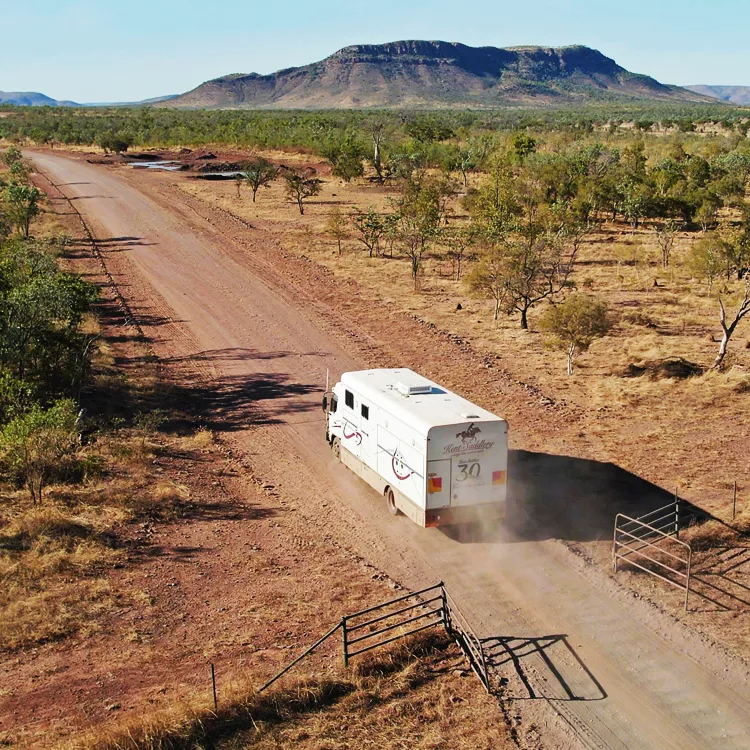Bernie Harte – Miranda Downs, Nth Qld
“My Country”
Bernie Harte has been at Miranda Downs in Queensland’s Gulf Country, for four seasons, with a head and heart full of memories of a life lived among stockmen, cattle and horses; but mainly in the wide open spaces of the Barkly Tablelands, NT.
He describes it as “my country”. “Its country where I feel comfortable,” he explains. “A lot of people don’t. A lot of people look out on those big open plains and they panic, out on their own. I’m a bit the opposite. It’s where I cut my teeth and you know you always have an affinity with the place where you first headed out. I know some of the history of the Barkly, and the fellas who opened it up must have had hearts as big as flour drums! Stone the crows…….to get across there and do what they did! It’s also the best cattle and horse country in the world bar none as far as I’m concerned. You know, that red linders and the Mitchell grasses are standing hay, terrific feed. The days of the bullocks have passed, but I still remember those big shorthorn bullocks and fat cows; they were top class lines of stock.”
Bernie sits, surrounded by an impressive collection of twisted greenhide ropes and hand plaited halters. They represent the skill and lifestyle of a bygone era; a time which Bernie recalls with detailed enthusiasm. In photos from his youth, hat style and beard seem to have been a part of who he is, and when asked has he always had a beard, he replies quick as a shot, “Not up till I was about 14. I didn’t have one before that.”
Born in the Burnett River region, and leaving school at age 15, Bernie began work as a stockman at Woolga Downs, outside Tambo, Qld, on the Ward River. He joined King Ranch Development at Tully River Station, and in the early 1960’s went to Brunette Downs contract mustering with drover and musterer, Billy Bowes Snr – ‘old Bowesy’. These were the yearswhen shorthorn cattle were being replaced by the Santa Gertrudis breed on Brunette.
When asked about the differences between now and then, he replies, “Well, the old ways? Those were the days of Broncoing, the bronco horse, men on the ground, and everything associated with catching a beast off a horse. It was a skill; a lot of skills are lost now. There were plants of 100 to 120 working horses, changed every 6 to 8 weeks if we could, and stock camps of 16 to 20 men, including horse tailers and a cook.” Bernie describes leg rope men “who could roll a leg rope along a hard yard and not even look where it was going. They were deadly. Bronco branding required a certain amount of skill. We weren’t supermen; it was a matter of doing it, we had to do it, and you keep doing something for long enough you gotta be half handy at it.”
Bernie talks about the aboriginal stockmen. “Stock work at the time relied heavily on these men and they were good men, and good stockmen. There were some beauties. Most of them are dead and gone now, poor old fellas. Everyone knew their job, and we all came together and worked as a team. It was essential for work at the bronco panel where things got a bit lively at times. There was more emphasis on team work than there is now. That was well over 30 years ago, and there are very few of those types of bushmen and horsemen left in the Barkly.”
Bernie took on contract horse breaking at Brunette (80 to 100 horses per year) and other stations from the Daly River District, to the Belyando in Queensland. Nothing under six years of age and a lot 7 – 8 years, and he remembers clearly when running a fresh plant, the action and excitement that surrounded the first ride on a fresh horse. “This was often a colt that had one or two rides and got away for a couple of years. I remember one day, at One Mile Yard and you’d never see it again in a hundred years, four blokes saddled up at roughly the same time; they must have stepped on within seconds of each other, and suddenly there were four horses straight up, bucking in four separate yards. We’d have our little performances running fresh horses; that was normal.
Every stockman had four or five horses in his string and they were worked in turn. Stock camps spent more time camping out. They didn’t like us hanging around the station for too long. There was always a camp cook , and a cook’s boy who shifted the beef around in the shade, and helped pack up when it was time to move camp.” Bernie describes the stock camp work in those days as very similar to droving, the only difference being that droving was along a stock route and station work was going over a beat.
“Cattle were often held in the bronco yards, with bullocks and fats on one side and breeders on the other if we were lucky enough to have two yards, otherwise the bullocks were watched. Holding the cut was an art, and a night watch, with a fire in each corner of the turkeys nest, was often part of the routine if we only had the single yard with the bronco panel.”
Bernie talks about the letting out of cattle, the importance placed on mothering up, and the necessity of having “true horse tailers” as Bernie describes them – often aboriginals who camped with the horses and were skilled in handling them. There were also some fairly handy white horse tailers. “All those methods have been phased out and it’s like somebody’s just pressed a button and everything changed overnight. The B-tech era in which all cattle had to be tested for Brucellosis, marked a turning point in the cattle industry and the necessity to work cattle differently. It really spelled the death knell for a lot of the good old ways, although it improved efficiency in certain areas.” Bernie, while recalling those good years now gone, is realistically philosophical when he maintains that “Cattle are still cattle and horses still horses and you still have to ‘read’ them. However a lot of the things that attracted me to the Northern Territory and to this game are not around now, it’s all disappeared.”
On the subject of ropes, Bernie still keeps those memories alive with an interest in and ability to process greenhide and cut it into strips for twisted and plaited ropes. “ rom the days of bronco branding it was a case of ‘had to’, using readily available green hide to make neck straps, hobbles, ropes and whips.” Now Bernie says, “It’s a job you can do sitting down in the shade.” He recalls the days when fresh hide from a killer was cut into strips and twisted up “by carbide lamp” (evening). “It was best left for a week and you’d tee up with the bore runner to take up the slack two or three times after the camp had moved on. The plaited halters are a Snowy River, Monaro country idea – great plaiting country, where they’d sit around those big fires in the cold with half a bottle of rum and a sharp knife, plaiting away. There was a fella down there, “Straity” Pendergast, who had a big reputation. He would go down to the creek, find a bit of half perished crinkly old hide, and by dinner time he had transformed it into a whip and was riding along chopping at butterflies that afternoon.”
Bernie calls Herberton home, spent time working in the Philippines and speaks favorably of the Snowy Mountains, and the Atherton Tablelands.
Asked if the Qld Gulf might represent the next part of his life, Bernie laughs, “I was doing some relief work at two Northern Territory stations for Kidman during Christmas 2007, and all the time I was out there I was having tantalizing images of barramundi fillets and red claw as big as whip handles swimming around in the Coolabah swamps of the Gilbert River! I thought, “this Gulf Country is starting to get hold of me!”
No doubt there are many more accounts of people and places; of different ways in different days. Bernie holds them in his memory, but for the here and now he concludes, “This is the next section of my life – the one I’m going through now.” And, stone the crows, we can see he’s determined to make the most of it.
Image captions:
1) Bernie Harte with handmade greenhide halter and rope.
2) Bronco branding, Brunette Downs, 1968
3) Bernie breaking in at Tanbar Stn, SW Qld, 1983















